The Terror Of Euro Television
by Aleksander Chan
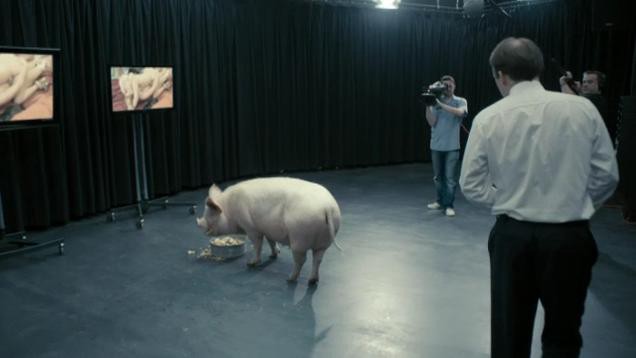
If you are ever in the spoiled, lucky position to watch television for a living, it would be wise to avoid tabulating the length and frequency in which you spend in front of the TV, your mouth agape, crumbs speckled along the edges of your shirt collar, your head pliable as a block of left out cheese. There is no accounting of this time without courting depression. Save those feelings of regret and inadequacy (I could have been doing so much more with my time! you lie to yourself) for when your cable bill — which is still $200, still a complete a shock after all these years — arrives in your inbox. But if I were to taxonomize my year in TV watching, what would immediately stand out is the amount of time I spent watching international death dramas. Or rather, how I watched them: through the cracks of my fingers or obscured by a pillow or sometimes without even looking at the screen, my eyes often welled with tears.
2013 was a banner year for international series. Many of them were English, but there were shows from France and New Zealand, too. Most of these buzzy and talked about shows — specifically Broadchurch, The Fall, The Returned, Top of the Lake, and Black Mirror — centered on chilling conceits: murder, death, violence. This was the year of television that instilled in me an irrational fear that foreigners might try and kill me. Yes, Americans have been killing each other on TV for decades now: Three separate Top 20 Nielsen franchises (Law & Order, CSI, NCIS) were built upon the premise of gruff leading men (and Mariska Hargitay) trading pithy back-and-forths with leggy co-stars while solving the grisly, grossly sexualized murders of coeds, scorned lovers, and unfortunate secondaries. But where 2013’s crop of imported death dramas stand out is that their killers felt like people I do or could or have known: The handsy boss. Your best friend’s husband. Your dweeby co-worker. Your grief counselor. But also because these shows divert our focus away from the acts of violence and the stack of dead bodies and make us look closer at the bleaker, headier horrors of human nature. To show us the misery of dread and the suffering of living, the ways guilt wears us down and make us cold. Facing the permutations of this psycho-emotional shakedown felt more draining, grueling, and terrifying than the hunt of their killers.
First we got the American adaption of Danish series Forbrydelsen, AMC’s perpetually cancelled and resurrected — and all too fitting given its title — The Killing. At first, the story of Rosie Larsen’s murder and the moody, no-bullshit detectives tracking her killer, was promising. That lurching, devastating moment when Rosie’s parents get the call that she’d gone missing, of Michelle Forbes falling to the floor in a mother’s agony, felt like echoes of Grace Zabriskie getting that same call in Twin Peaks. But it dragged, prolonging the killer’s reveal and confusing rain and grey skies with emotion. (FX’s The Bridge, yet another adaption of a Nordic series, bored me.)
This year, the one-case-a-season approach earned its stripes by tightening their storytelling. Part of why these international dramas worked is their serialized but still contained nature — unlike network procedurals, they aren’t trying to churn out 22 42-minute episodes of close-ended crime solving a season. (And that’s mostly because of the nature of foreign television production models, which are much smaller than they are in the U.S. and are often government-funded.) American cable dramas typically run 12 to 13 episodes a season, which can still feel bloated (I see you, Homeland), but I think these international shows, which tell singular narratives across eight or so episodes, figured out just the right amount of space to tell these stories — they’re tighter, punching hard and fast.

To wit, the most painful 20 minutes of the U.K.’s Broadchurch wasn’t when they finally caught the killer of an 11-year-old boy who lived in an idyllic seaside town. It was watching the killer’s son being told the truth about his father; the boy’s family finally being informed by David Tennant’s detective that their good friend and neighbor killed their son. It wasn’t ghoulish. It didn’t at all feel like an easy, manipulated emotional moment. It just felt fucking awful. They were spare, almost quiet moments of overwhelming grief, of you watching these families faces slowly crumble into tears. Broadchurch and these other prestige international dramas this year, in different forms, considered the ugly idea that knowing that someone you love could be that terrible, could betray you so cruelly, can feel worse than their crimes. American murder dramas seem glib by comparison.


The one most people heard about was Jane Campion’s Top of the Lake, a buggy, Lynchian freakout set in New Zealand (and co-produced by BBC Two). A young, gung-ho detective, Robin (Elisabeth Moss), who left years earlier following a horrific attack on her way home from a school dance, is trying to figure out what happened to young Tui Mitcham, who goes missing after submerging herself, possessed J-horror villain style, into a lake. Before she goes missing, it’s discovered that Tui is pregnant and when questioned about who the father was, she tells Robin, disquietingly, “No one.” But it turns out Tui’s mystery and Robin’s repressed trauma are inextricably linked: Robin was raped by a gang of thugs when she was a teenager. And she’s horrified to learn — years later and after carrying a baby that resulted from her rape to term — that her old flame (and Tui’s half-brother), who she has now rekindled a romance with, and who was there at the time of Robin’s rape, didn’t do anything to stop it when he had the chance. He froze up and let it happen.
The series takes a rough edge to institutionalized gender politics and attempts to unpack the ways in which we cast blame. Women in Top of the Lake are victims, targets, and enemies; men are monsters, fiends, or creeps. The implications of Robin solving this case are huge, because they challenge the system of patriarchy, of unchecked authority and quiet complicity, that forces men and women into those roles, and that allowed for the crimes committed against her and Tui to have happened in the public eye without consequence. It’s an indictment of how we turn blind eyes to terrible things happening right in front of us. It’s scary and unsettling and Top of the Lake, with its roving camerawork of the bucolic New Zealand hills, makes you feel its bristle all around you. It’s like Jane Campion walking up, slapping us in the face, and asking, “Do you see it?” with an appropriate jolt.


Set in Belfast, Ireland, The Fall is closest to what we’re already used to with serial killer dramas. The show follows murderer Paul Spector (Jamie Dornan, former model and future Christian Grey) and the police officer tracking him, the blithe and brilliant Stella Gibson (Gillian Anderson, who still kicks ass). Paul is targeting young, upwardly mobile professional women; he slinks in through their windows, his face covered like it would with a ski mask, and strangles them. Strangulation! No fancy trap to be laid, no bizarre ritual to adhere to or pentagrams to draw — just old-fashioned murder-by-bare-hands. It’s scarier to be reminded that we posses the sheer force of will and animus to kill each other without any superpowers or machines.
But where the show was most successful, other than fostering an incredible sense of fear (lock your doors!), was how it forces you — through meeting his family and seeing how him and his hardworking wife struggle to keep their spark — to sympathize with him. So that when he’s killing victims, there’s layers of misery: for the woman being strangled to death, screaming in abject terror; for Paul, who you wish with all your might would stop; and the dark, icky feeling you have for emotionally standing on the side of a killer. There are obvious parallels to Dexter, but where I think The Fall has an edge over Michael C. Hall and his endless hardboiled narration is that Paul’s crisis feels decidedly more quotidian — Dexter was such a pro, his emotional center guarded by an impregnable fortress. (Which I know was the point, but I stopped caring when the show went about slowly breaking down those walls.) Watching The Fall is to experience the macabre internal nightmare of a killer, which feels perilously similar to someone who isn’t.

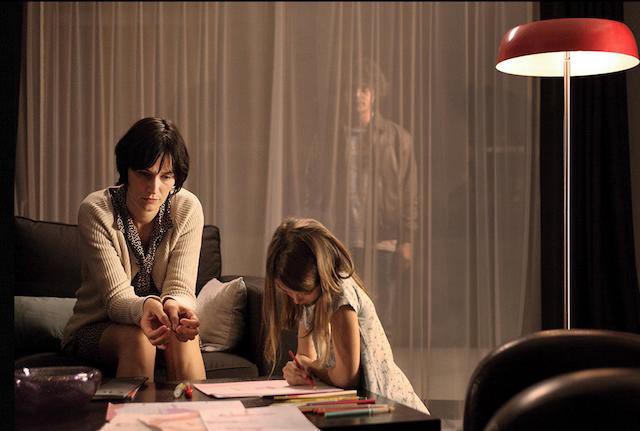
France’s The Returned and the British, Twilight Zone-esque Black Mirror are not directly about killers, per se, but they are obsessed with death and the emotional margins surrounding it. The Returned is a pseudo-zombie thriller, but not like The Walking Dead — the people who have come back to life aren’t trying eat anyone. (OK, one of the returned is a serial killer and there are weird, supernatural elements in play, but the series’ emotional undercurrents operate irrespective of that fact.) In fact, they appear perfectly normal and very much alive, years after they died. Ignorant of what happened to them, the series follows them as they try to reintegrate themselves into the lives they don’t remember ending. The Returned, and especially Black Mirror, play with the dark side of wish-fulfillment: How does your deceased loved ones suddenly coming back to life affect your ability to grieve, to finally move on? Their return also reignites the fear that you’ll lose them all over again, perhaps weighing twice as heavy on your heart than the first time you lost them.
All this to say, I really want you to watch Black Mirror. It’s hard to find stateside (it aired on the DirecTV-only Audience Network), but if you can get a hold of the show’s six episodes, you’ll be floored by how it takes ideas like those in Dave Eggers’ The Circle to truly horrifying, devastating places. I was a wreck after every episode. A collection of closed-ended episodes about the way we live now (so, huddling and clacking away behind screens), each takes place in a future where technology has made logical, obvious advancements; you could envision them today and nobody would bat a lash. In fact, they’ve probably already been cooked up in the brain of a future billionaire or sketched out on a Silicon Valley whiteboard of a startup desperate to “disrupt” something (mostly themselves): advanced computer systems that we can embed in the sides of our necks that record everything we see and hear, to be played back on the device of our choosing, including our own eyes; a world in which literally every action is quantified (and gamified), where brushing your teeth costs “merit points.”
In these visions of the future, we’re doing a fine job of using the technology — the apps and the devices we made to make our lives easier — to live in unbearable misery: in the first episode of the second season, “Be Right Back,” a young artist’s husband, distracted by his phone, dies in a car crash. Stewing in grief, the widow impulsively purchases the service of a company that allows her to “speak” with her dead husband by scanning his social media profiles, personal data, photos, and audio clips and algorithmically regurgitating his likeness. (So, a souped-up Twitter bot.) Just as in The Returned, the woman’s “resurrected” husband is a prison she’ll never escape, never finish serving time. Eventually, in a grim turn for an already depressing allegory about the corporate profiteering of bereavement, she’s able to purchase, implied to be for an amount she can’t afford, a robotic replica of her dead husband, made lifelike by an advancement that allows scientists to grow synthetic human skin. When we caution to others that we should be careful about what we do or say online, we say so because what happens on the internet “lives forever.” Black Mirror posits: If we put enough of ourselves online, can we live forever? And do we want to?
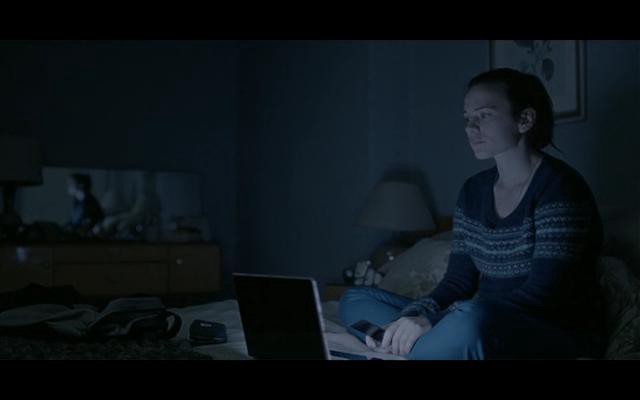

American networks, faced with cratering ratings (which really may be more of a matter of figuring out a better way to measure ratings, given all the ways we watch TV now), Netflix, and competition from cable, and inspired by international series, are catching on to the idea of limited-run seasons (or just trying to make American versions of those shows). They keep calling them “event series,” which is dumb, but seems to be working: their smaller episode orders, and therefore more flexible shooting schedules, have drawn bigger stars like Kevin Bacon, Toni Collette, and Halle Berry. Fox is even shooting an American version of Broadchurch to air next season that will also star David Tennant (which also seems dumb, but at least they’re trying?) and Breaking Bad’s Anna Gunn. I’m all for these eventual “event series” if it finally leads to the dismantling of the archaic, useless 22-episode network TV production model. (Sorry, we don’t need 22 episodes of Scandal. We don’t need 22 episodes of one season of any show.) Because what made the international shows I watched this year feel so powerful was their economy. Each season (excuse me, “series”) felt complete. And though I wouldn’t say no to more of any of them, I’m happy with what I’ve already been given. Less is more.
Aleksander Chan is a writer and editor in Austin.
Our National Box Office Nightmare
by Rahawa Haile

The bulk of this year’s action and sci-fi films did clever violence better than in previous years but generally failed to develop minority characters. I mean the frequently derided popcorn fare such as Fast & Furious 6, as opposed to the hallowed and equally problematic Chilean Sea Bass fare of films such as Captain Phillips: The Wrath of Khat. A great deal of my fascination with the former subset stems from a desire to see smart, setting-specific violence that draws upon the elements of cinema as much as it does its surroundings. More often than not, this is something beyond the bullet and therefore historically unspecific to the white male hand.
Occasionally, one witnesses Hollywood taking risks with its audience. A dog is seen shot to death on the White House lawn. The female protagonist in Pacific Rim is permitted to sport thick eyebrows. However one might spell subversive, instances of it are peppered throughout the many films written off as spectacular, unfathomably expensive failures. So while movies such as Olympus Has Fallen may possess the most useless rack focuses of 2013 (this one into a Christmas tree ornament), they can also turn out to feature strong, single fathers of color who takes care of their children, as in G.I. Joe: Retaliation. Or assertive and physically capable female martial artists and soldiers (as in G.I. Joe: Retaliation). It is possible for you to see a testosterone-driven film with a budget of $130 million that isn’t dependent on a single love interest (G.I. Joe Retali — you get the idea). G.I. Joe was also the only action film I saw this year where, among other things, the most sexually fetishized character was male (Byung-hun Lee as Storm Shadow).
There is a tendency to lament a lack of such representation as though it does not exist at all. One needn’t look hard to see why. Gwyneth Paltrow’s Pepper Potts practically apologizes for her newfound superpowers in Iron Man 3. Star Trek’s Zoe Saldana plays what amounts to a petulant, subpar Klingon speaker in Star Trek: Into Darkness. While I failed to watch Red 2, Kick-Ass 2, 2 Guns or a handful of other numerically minded ventures, the change between how Fast Five treated its women (letting them design and implement strategies) and Fast & Furious 6 can be summed up in one line: “Woman, you don’t pick Shaw up like he’s groceries.” Villain or hero, if you are a woman in this movie you are going to die. Or almost die. Or are already dead but not really and you still might die. If somehow you manage to live, you will be very, very lonely.
Pacific Rim employs a similar sleight of hand. Visually, it’s a very dark movie, with many of the dull Jaeger (nuclear-powered robots) vs Kaiju (monsters from another dimension) battles taking place at night and/or in the rain. And yet by the end of the film, there is enough cooperation — between the cool, young American scientist and the dull, reserved British mathematician, between Raleigh the male American hero and Mako the female Japanese heroine, between the one father who is on the verge of death and the Australian father who is on the verge of losing his son — to make it feel as though, yes, America has won, but America hasn’t exactly “saved the day,” at least not alone. Except that it has (and won the girl, to boot).
As you’ve no doubt heard, the level of destruction we are meant to gloss over in these films is unreal. Not in the callous and manipulative way New York Magazine’s Kyle Buchanan and his ilk suggest, but in a blatant attempt to bridge whatever nominal gap exists between the summer blockbusters of today, and their typically morally liberated counterparts: video games. From the first-person-shooters of Olympus Has Fallen and White House Down to Man of Steel, Fast & Furious 6, and Star Trek: Into Darkness, an action movie no longer needs to exists as a progressive collection of scenes: It is, after its first act or cutscene, a formulaic series of levels. Sometimes you get to drive a tank.
After A Good Day to Die Hard, The Wolverine would have to be the worst action movie I saw this year. Despite it opening with three Japanese men committing seppuku, there is virtually no blood in its 10 hours other than that belonging to Wolverine himself, a plot point (though not scene) as lifeless as the Lois & Clark: The New Adventures of Superman episode where Dean Cain gets a papercut. The Wolverine replaced superpower-based fights that even X-Men Origins: Wolverine got right with a mindless herd of Yakuza henchmen and chopstick lessons. It gave the Silver Samurai a few minutes of screentime and then killed him. It kept the line “The mutant has powers!” The female villain Viper was also condemned to the worst superhero costume in the history of cinema, and that includes The Specials.
I can only assume that all the blood that should have been in The Wolverine went to Riddick instead. Everything from the rocks to my eyes bled, because apparently there’s no greater conquest in a Vin Diesel movie than turning lesbian characters into willing sex partners with one’s Vin Diesely vim and vigor. It’s a shame since I was ready to rave about how Katee Sackhoff’s (Battlestar Galactica’s “Starbuck”) lesbian character was the best adult female action heroine of 2013. That is to say, the character beats the stupid out of men. When they hit her, she hits back harder. She is skilled with weaponry. When sexually propositioned by a scumbag, she answers, “I don’t fuck guys. I fuck them up.” It’s refreshing until she straddles an unsurprised Vin Diesel upon notification that the film has neared its end.
But no one consistently fared worse in action films this year than black men. In 2013, if you were a black man with a speaking role in a blockbuster movie, you were almost certainly in the military. (Remember the outrage at the National Guard’s Man of Steel advert? Imagine if the people who looked like you inside the film served as one, week after week.) What’s more, the black men also primarily acted as antagonizers to the (often) white female protagonists in these films — the people viewers were actually rooting for.
If I keep returning to women in action movies that’s because there is no reason for us not to have a star outside of adaptations. One who doesn’t keep dying in her films (e.g., Michelle Rodriguez). The numbers are dismaying.
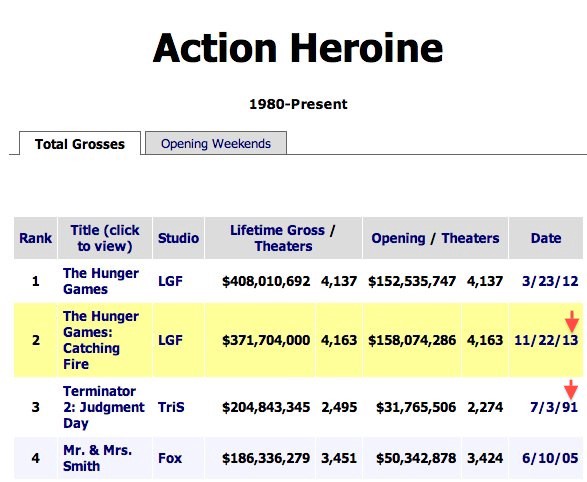
Before The Hunger Games, the largest grossing film featuring an action heroine was from 1991, Terminator 2: Judgment Day; three out of the five top earners starred Angelina Jolie: Lara Croft: Tomb Raider, the remake of Mr. & Mrs. Smith, and Salt. Action-horror doubled as the past decade’s refuge for female leads with guns. The four Underworld movies combined had a budget that was still $37 million less than this year’s The Lone Ranger. The sum of all five Resident Evil films cost what it took to produce 2012’s John Carter, except that the former’s worldwide revenue is over $900 million versus John Carter’s $284 million (admittedly this is only a year on). Yet the critical reception of these film series has hovered near rock bottom. The highest approval rating on Rotten Tomatoes for any Resident Evil film was 34%. The highest rating for an Underworld film? 33%. Conversely, the most celebrated action and sci-fi films have housed the least present or competent female characters. Make a list of your favorites from the past five years? Inception? Looper? Star Trek: Into Darkness? Did the majority of women in those films do anything notable? Be a memory? Not know how to shoot a gun? Speak Klingon poorly? This??
So yes, on the one hand, hooray for surprising grenade necklace deaths in 2013. But it’s hard not to feel as though it must be nice to be the white guy in all these films (or Vin Diesel), and my, how great it would be to view something different. As it stands, there were more capable women in White House Down than in Oblivion, Iron Man 3, and World War Z combined, and none of them was interested in Channing Tatum.
If anything is to be mourned in this year of action it should be the continued collective dismissal of the medium shot during fight sequences. That and the much-discussed flattening of film scores, for this was the year where soulless aural accompaniment with allegiances to the lowest frequencies blurred into one. Do you remember what Star Trek: Into Darkness sounded like? Or Iron Man 3? Thor: The Dark World or Ender’s Game? World War Z? There are many who subscribe to the belief a score should not be noticed. It has resulted in films with the aurally thematic nuances of mud. It has also resulted in M83’s Oblivion score, Hans Zimmer’s Man of Steel score, and Ryan Amon’s Elysium score being among the most accomplished of this year’s offerings. That said, despite its critics, I hope Man of Steel — one of the year’s most divisive films — is remembered as the first time dubstep destroyed a city, for how the sound of the drop leveled Metropolis, not Kryptonians.
Rahawa Haile is a Brooklyn-based writer. You can find her on Twitter.
HitRECord on TV Premieres January 18th on Pivot
by Awl Sponsors
Launched in 2005, hitRECord is an online collaborative production company founded and owned by actor and director Joseph Gordon-Levitt. This global online community uses video, music, literature, photography, animation, graphic art, and more to makes various short films, books, and other projects from individuals around the world.
Now Joseph Gordon-Levitt and hitRECord are leaping from the Internet to television with the new pivot series, HitRECord on TV. This half-hour variety show will feature short films, live performances, music, cartoons, and more! HitRECord on TV premieres Saturday, January 18, on pivot at 10 pm ET.
Pivot is a new television network that focuses on entertainment that sparks conversation, inspires change, and illuminates issues through engaging content. Learn more about pivot and HitRECord on TV at http://www.pivot.tv/shows/hitrecord-on-tv.
The Year In Cats Getting Stuck In Ridiculous Places
by Matthew J.X. Malady

Just a few days after we turned our calendars from 2012 to 2013, NBC Bay Area posted a story on its website under the bizarre headline “Fat Cat Rescue Highlights Cathood Obesity.”
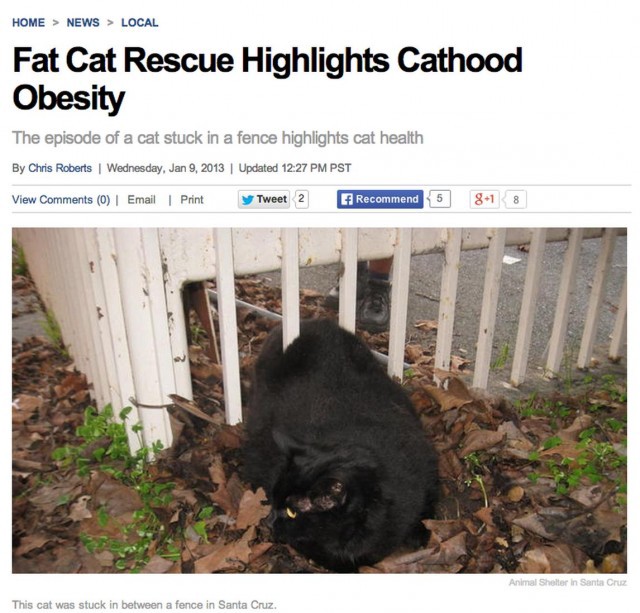
The cat referred to in that headline, Midnight, weighed 14.4 pounds at the time of its rescue. The corresponding article noted that the portly pet’s “‘ample hips’ needed massaging and squeezing before she could be freed” from the space between fence posts.
Remarkably, as the year progressed things got even more ridiculous with respect to cats being trapped in stupid places. And just in case some of you may have missed one or two of this year’s wackiest stuck-cat news stories, it’s probably a good idea to squeeze in a wrap-up before 2014 is upon us and cats start getting stuck in ridiculous things from the future, like 3D printers and shoes that enable humans to fly.
Let’s begin with the classic of the genre: Trees!
Cats love getting stuck in trees. They just do. If you don’t believe me, then you’ve clearly never run the Google Image search “cats stuck in trees.” Also, you’ve never talked to Piney, the Bakersfield, Calif., cat that was stuck in a tree for 13 days during October. (According to news reports, “the cat was chased up a tree by a stray dog.”) For further confirmation, you can hit up this little orange dude who got stuck eight stories above the ground in a Hackensack, N.J., tree around the same time.

If you’re still not convinced, here’s this, this, and this, all from the past 12 months.
And there are hundreds more where those came from. So just trust me when I say that 2013, like every year before it, and every year to come, was marked by lots of cats getting stuck in trees. But, really, trees are pretty boring when it comes to cats getting stuck. What made 2013 such a noteworthy year for cats getting stuck in crazy predicaments was the impressive range of ridiculous places cats were finding themselves trapped this year.
Cats that decided to go outside ran into some especially hairy situations in 2013. This is not to suggest that cats that stayed inside were less likely to become stuck in ridiculous places — we’ll get there, don’t worry — but it really is the case that if you are a cat that hopes not to get stuck in or on something, going outside is probably not the best idea.
This is doubly the case if it’s winter and the place where you are going outside is named South Dakota. In fact, I’ll go out on a limb here and say that it’s no fun being a cat in South Dakota. Just ask the cat that froze to a damn pond this past February in the town of Yankton.

According to a report in the Yankton Press & Dakotan, the individual undertaking the rescue in this instance “had to chisel the cat’s tail out of the ice.” After helping bring the animal to safety, the town’s deputy fire chief noted, “She had been there long enough that there was an indentation in the ice where she had been sitting.”
A few months later, in April, a cat in Indiana climbed atop a freeway sign, sat on a light, and couldn’t get down for two days.

After rescuing the cat near Elkhart, Ind., someone decided to name him “Freeway.” Then, according to local reports, lots of people in and around Elkhart flooded the area humane society with calls about adopting Freeway.
I’m not certain what happened next, but if I had to guess I’d probably say that Freeway arrived at a loving home, looked around, and promptly went about the process of getting stuck in a basement wall.
Did I mention cats love getting trapped in walls? Well, they do! In April, near Miami, a kitten got stuck in a wall of a family home for several days. And since the kitten was also, you know, a cat, getting it unstuck was a complete pain in the ass. “It took two agencies and approximately 10 firefighters to get this kitten from a wall,” a local fireman told NBC Miami, “it was pretty well hidden.” Not to be outdone, a Michigan kitten found itself stuck in the wall of a Detroit gas station for three days in November. Cats really need to watch out for walls.
And while we’re at it, seriously you cats: Enough with the whole getting stuck in car engines thing! It’s super dangerous. Also, when the cars you’ve gotten stuck in go places that you don’t like, there’s really not much you can do about it.
Just ask this grumpy cat…
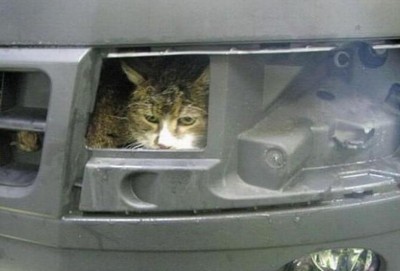
…that had to go through a car wash after getting stuck under the hood of a car in April.
Drains would appear to be a big problem, too. In October, firefighters in South Los Angeles used a hamburger to convince a kitten trapped in storm drain for two days that it really needed to come out and no longer be stuck. Meanwhile, this summer, in York, Pa., a cat got stuck in a sewer drain leading to a most unexpected and unfortunate chain of events. It’s unclear what happened to the cat, but when no one responded with help after three 911 calls, the animals’s owner decided that this show of municipal negligence was the last straw for her in that southern Pennsylvania town. “Just another reason I am selling my home in York,” she wrote in an angry letter to the local paper.
And lest you should think it’s only American cats that act all bonkers and get caught in tight places or stuck high in the air, other countries appear to have at least as many zany 2013 stuck-cat stories as we do.
In January, for instance, a cat in the UK named Polly got trapped on a train and traveled nearly 1,700 miles before she was rescued.
According to a write-up on SWNS.com, the trouble began when the cat “climbed inside the ‘raft’ below the carriage which houses the air conditioning and batteries and which is only accessible when maintenance panels are opened.” Fortunately for Polly, she had been microchipped. So after being rescued, and operated on for a broken leg, she was returned to her owners in Plymouth, not far from the southwestern tip of England. Thereafter, Polly went home and promptly got stuck in a wall. (Kidding! I kid.)
A few months later, a cat named Nigel found itself stuck between the floor and ceiling of a Toronto apartment for 11 days. According to a piece in the Toronto Star, the cat became trapped while its owners were out of town and their bathroom was being renovated. Once it was determined that the cat was stuck in the ceiling, its owners had several large holes cut and tried coaxing it out by reading aloud to the animal.
No dice.
Ultimately one of the cat’s owners had to pull Nigel out by his tail. “That’s when he started fighting… it was chaos,” the man told The Star, noting that he got all scratched up.
Then there’s the story of the cat that decided to get itself trapped in a Newcastle, South Africa chimney this past September. Here again, these cats don’t make saving them easy. “When we went out there, we discovered that the fireplace had been boarded up,” an SPCA inspector told the local newspaper, “and the only way to get the cat, which was stuck at the bottom, would be from the chimney entrance on the roof of the house.” So some kind soul named Sphelele Manyathi had to go down that chimney — which, according to reports, possessed a “horrific” smell and was “overgrown with grass and plants and dirt.” After saving the cat, Manyathi noted that it kept attempting to scratch him throughout the rescue process.
One month later, in October, a Scottish cat named Coco caused a power outage in the town of St. Cyrus when it got stuck at the top of a utility pole.

And in November, a cat in Manchester spent three days stuck on the ledge of a viaduct, 90 feet above the ground.
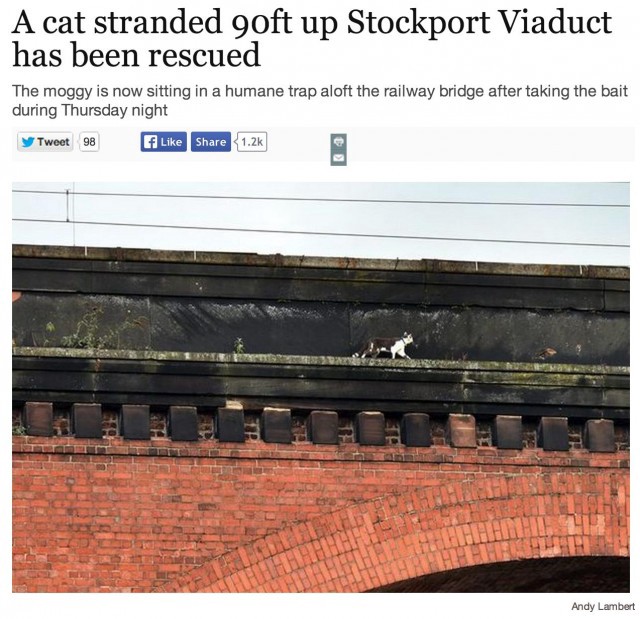
After a harrowing rescue, the viaduct cat was given the name “Lucky” and an RSPCA representative told the Daily Mail, “It was a very precarious position the cat managed to get itself into.”
A better quote would have been something like: “This is what cats do, people! They get stuck in ridiculous places. Sometimes they’re really high up places like this one. Other times it’s in a wall, or under a bookshelf, or upside down behind the dryer, or whatever. So, really, this is nothing out of the ordinary. It’s just a cat getting stuck somewhere crazy.”
In lieu of going on forever, I’ll just note that this year also featured cats getting stuck behind water heaters, in sofas, in toilets, in vending machines, in pipes, in dog doors, at the bottom of really deep holes in the ground, and in pretty much any household items they could fit some part of their bodies into. But perhaps the oddest stuck-cat story of 2013 happened in Queens, N.Y., this past spring.
In mid-March, as reported by The New York Post, NYPD officer Dane Natto responded to a 911 call about a cat stuck in a tree near PS 213 in Oakland Gardens. Natto climbed the tree in an effort to grab the cat, but after a while he realized that he was stuck and could not get down.
“We looked out the window, and we saw the cop inside the tree — sitting,” Luna Giuong told the Post. “[His] partner was laughing at him.”
Calls then went out to the NYFD for a double rescue, and when firefighters arrived on the scene they proceeded to assist the cat before turning their attention to Natto. “They all gathered around and laughed at him,” Giuong added.
But the laughing stops now. You see, this thing in Queens was just a trial run for the cats. A more finely tuned, synchronized version of this “cat pretends to be stuck somewhere ridiculous and then gets humans stuck instead” thing is how we all will die. One day all the cats on the planet will simultaneously become stuck in dangerous, stupid places — slippery rooftops, edges of rocky cliffs, New Jersey — and we will all attempt to help them. Then we will get stuck and eventually perish while all the cats in the world lick their paws in quiet contemplation and zoom across rooms without realizing that they can’t stop very well on hardwood floors and leap high into the air at odd times for no apparent reason at all.
Matthew J.X. Malady is a writer and editor in New York.
This Restraining Order Expires On Tuesday
by Natasha Vargas-Cooper

The first time “Misty” broke into the backyard to pound and scream at the bedroom window, the police handcuffed her and said — her face pressed to the hood of the idling black and white — that she was not to return. I figured we would never see her again after that early morning in 2012. But the next night, around 1 a.m., I was in bed with my new boyfriend, “Scott,” and we heard the bedroom door slowly crack open. Scott jumped up. “No! You can’t be here!” he shouted, all high-pitched.
At the end of this calendar year, our second restraining order against Misty expires. The Misty saga (this is the truncated version) has pushed me to the limits of empathy. It has been an education, of course, but one streaked by repulsion, rage, and pity. It has been my first true introduction to madness, the sort there is no reasoning with, that is beyond mood or medication. It is pre-social and it is dangerous.
Misty would eventually bring violence into my bedroom, and violence is ugly, and it brought out something terribly ugly and deformed in me.
Over the past year I’ve clandestinely kept tabs on Misty through Facebook. I’ve learned about the suicides in her family, about the casual violence she grew up around, the deeply tumultuous relationship she has with her parents. Depending on her mood, she will sometimes refer to things irreverently, other times with a palpable sadness. Sometimes I want to reach out and offer a friendly ear, since we share some sort of perverse history. Before Scott and I moved out of his house, I slept on the same mattress she once did. But then there are other times, when I think about her and I want to hit her very hard, harder than she hit me.

Scott and I have known each other for 15 years and I have always harbored a crush. I saw him in his high school’s production of Les Misérables where he played the convict-turned-factory owner Jean Valjean, wearing a midnight blue army surplus jacket meant to evoke the fashion of revolutionary France. Scott’s voice cracked on a high note during his first solo and I swooned. This boy — who looked like a football player and sang bravely in front of his indifferent classmates — seemed to have the perfect combination of sap and mettle.
Last year I heard that Scott had just emerged from a snake-pit relationship. When I asked around about Misty, our friends said she was crazy. But I know the value “crazy” has in the currency of gossip. I know it’s a term most often applied to a female partner when she falls below the expectations of a group. Before my first date with Scott, I heard that he and Misty had formed a kind of cocoon of melodrama and sadness that kept the rest of the world out. She had ruined dinners and birthday parties through slow boiling tension that would explode behind closed doors into hysterics.
I text-messaged Scott for the first time in years, we grabbed dinner, I asked about Misty, he said that even though they had split four months earlier, every few weeks she would have some episode in the middle of the night, and call him 30 times in a row, then show up at his house if he did not answer. None of this bothered me, because Scott made me feel so full of life during our first night together, I felt like I had captured some glorious hybrid of Midwestern manners, extroverted modernism, with huge charisma and no active Twitter account. Scott, to borrow a phrase from e e cummings, unclosed me.
That first night, we stayed at my house, and after having an intimate conversation in bed, we noticed his phone had 41 missed calls from Misty.
Then came the texts. She was at his house.
12:03 AM: Where are you? I’m staying here
12:05 AM: Please come back. I’m not going to lose you. I’m not going to give up. Please come back I want to see you. I love you
12:06 AM: I’m too drunk to drive home, can I please stay?
12:10 AM: Ok I’m staying.
Scott turned off the phone. The next morning when we checked again there were 16 more:
6:41 AM: By the way the pup tore the shit out of the house, but don’t worry I cleaned it up. If you can’t take care of him then you need to put him up for adoption.
The “pup,” Levi, is a half-beagle, half-Boston Terrier Misty bought for $700 from a breeder during the nadir of their relationship. Misty and Scott agreed to some sort of joint custody since he had a backyard. This, of course, is a stupid plan for any couple looking to actually sever ties; not only involving a dependent living creature but also a joint set of house keys.
When Scott and I went to his house that morning to feed and walk Levi, we discovered Misty had washed all the dishes in the house and changed the bed sheets too.
My initial reaction to all of this was shock, but with a slight shimmer of recognition. I’ve also embarrassed myself for men. I’ve never slept in a guy’s bed without being asked to, but I have sent regrettably maudlin text messages to ex-boyfriends. I’ve shamelessly pleaded for a man to come back to me. And once, during a particularly devastating argument with a boyfriend who lived a few hours away, I called him for 20 minutes straight until he answered the phone. These were acts that I found incredibly shameful during the mandatory emotional inventory that occurred the next day. They were radical maneuvers from the emotional high-wire act of my early 20s where every relationship seemed like my last chance at love.
Had I not known Scott since we were teenagers, I don’t know if I would have stuck around — ok, that’s an absolute lie. I was totally intoxicated with Scott and voyeuristically intrigued by this trashy gothic horror show. I also believe that you can make someone’s life a little more tolerable if you help them say no to things that are bad for them (I learned this in a Twelve Step program!). Scott changed the locks and his cell phone number, and we made plans for dinner the next evening.
At 1 a.m. the next night, I came face to face with Misty. She was on the front porch, knocking gently on the door, politely, as if this were like any other visit. Misty explained calmly through the screen door that she was just there to see Levi and take him to “the beach for the weekend.”
I figured some huge wave of despair had brought her crashing onto his doorstep but she was poised and cool. No trembling, wild gestures, or mascara-made trenches on her cheeks. Scott called the police and asked her to leave. She didn’t move, except that she kept clicking her useless key back and forth on the lock, over and over. It was “no big deal,” she repeated flatly, her eyes glassy and expressionless. It was like witnessing what the psychoanalyst Wilfred Bion called “a thought without a thinker.”
Levi heard Misty’s voice and began to whine, yelp, and scratch at the door.
“Leviiiiii,” Misty called out. “Levi, come here, baby.”
Scott and I rushed the dog into the bedroom and waited for the police. Misty scaled the fence, ran to the backyard window, and started thumping the glass. She then lit a cigarette and began to make her case.
“Look, Scott,” Misty said in a conciliatory tone, as if sheer politeness would defuse situation. “I don’t know who this new girl is, and I don’t care, I don’t want you back, I have a new boyfriend now. I just want the dog, I don’t know why you’re acting this way.”
Up until this point I had been silent, letting Scott enforce the boundaries, allowing him to set up the new order of things. I don’t really do fights. I grew up an only child in a warm household with two communicative parents. I never got rough and tumble with a sibling and I never got a spanking. I can get mouthy and a little loud when in the throes of some domestic squabble, but nothing out of the ordinary.
And then something ruptured in me and I started screaming at the window. “Bitch, I’m the bitch who’s in this house! You’re the bitch outside of this house! You need to fucking leave! Get the fuck away!”
My plan, concocted in a nanosecond, was this: I would just shame her into leaving. She wanted a fight with Scott, but I wouldn’t let her have it, and I could think of no greater shame than getting yelled at by an ex-lover’s new girlfriend. Shame is probably the greatest regulating force of my 20s — the dark magic that compelled me not to do stupid things over and over again.
“Fucking leave! You need to fucking go!” I screeched.
She waited until I was done, and lit up another cigarette. “Are you really cursing at me? Really classy.”
I started to shake. What the fuck were we even dealing with?
Two LAPD cops put her in cuffs. Misty told them that Scott had kidnapped her dog. This created more confusion and yelling. The police said that without a restraining order and without Misty committing any acts of vandalism, they would have to let her go. This made us feel powerless. I had the suspicion that, if Misty had been a six-foot man the police would have taken the threat more seriously.
The handcuffs came off and Misty drove away.
We filed the emergency restraining order against Misty the next morning. I read Scott’s affidavit. In their 16-month relationship, she’d hit him, bitten him, slapped him, smashed his computer, swung a knife at him, then put it to her own chest and threatened self-slaughter. Surely, he too must have the seeds of drama and madness buried in his body, I thought. What would I do if the victim became the victimizer? I would silently wonder, with rankling dread: What red flags am I missing? How could he date someone as damaged and abusive as Misty?
That evening we tried to relax and rehash the prior events, thinking that we’d taken the final and necessary step. But something was stuck. I knew from my conversations with Scott that Misty didn’t just turn into a ghoul one day. Her sort of victimization is systematic and had to be, at some level, enabled by Scott. There were no children, no mortgages, no external pressures keeping Scott and Misty together, so, I reasoned, there must be some collusion, some trauma they were both living out (I also learned this in a Twelve Step program!). They were shadowboxers but Misty’s blows eventually became real and Scott lacked the foresight, self-regard, or courage to leave her. I tried to relax in Scott’s bed and just as I did, Misty appeared in the doorway.
“No! You can’t be here!” Scott cried, as he scrambled out of the sheets.
“I just came to see about the dog!” Misty shouted, rushing towards Scott.
Scott managed to wrangle Misty backwards away from the bed but she broke through and, before I could get fully to my feet, her arm swung back and I felt a fleshy thud against the side of my head.
She looked me in the eye, her nose ring glinting in the lamplight. “That’s what you get, you fat cunt,” she said.
She swooshed around, threw open the door (she had broken in through the window), and ran away into the night.
There was another series of confrontations with Misty but most of them took place in a courtroom, or through the unregulated space of fake Facebook profiles and anonymous emails. In the days after our first six-month order expired in 2013, Scott’s phone buzzed at 1 a.m.
It was text message from Misty that just read: ‘Hi.’

Have you ever watched two girls in a street fight? It’s very awkward and usually there’s more hair-pulling and grappling than blows because most girls don’t have practice in throwing a closed-fisted jab. But Misty’s punch was a precise, practiced blow, the sort I have never once received or delivered, but have certainly witnessed parents issue to a wailing child in a supermarket or to a disobedient teen. I think Misty has been on the end of that punch before.
I’ve spent a lot of time around foster teens and delinquent juveniles. I know that, usually, any maladapted behavior they show — violence, shoplifting, habitual lying — goes back to their parents. When you meet a kid in lock-up, you’re meeting someone whose family system has failed or was never there at all. Talking to them makes you ache for, and resent, the parents of these wayward kids.
Over the past year, I’ve tried to diagnose Misty. The best I can do is borderline personality disorder. When Misty’s fist plowed into the side of my head, I was thrust into “Borderland.” Psychologists use this term to describe the emotional universe that those who suffer from borderline personality disorder create for themselves and those around them. In her book for clinicians, How to Talk to a Borderline, the psychologist Joan Lachkar writes: “People who live in Borderland … make up their own rules, have a weak hold on reality, are unpredictable, impulsive and volatile; and hear what they want to hear.”
The people of Borderland are the psychological equivalent of third-degree-burn victims. They have no psychological skin to protect them from the push and pull of the outside world, so every movement causes pain and agony. All emotional movement in Borderland is high-stakes, and the population reacts swiftly, and severely, sometimes violently to anything they perceive as a challenge or a threat. Borderland, ironically, has no borders. It moves with its population.
Lachkar describes the characteristics of the disorder: low self-esteem, loss of ego identity, suicidal ideation, impulsivity, acting out, inflicting harm on self or others, persecutory anxieties, abandonment and betrayal fears, distorted sense of dependency. Victimization. Intense rage.
There is no gene, that we know of, for borderline personality disorder. Borderlines are most often made. Unlike bipolar depression, psychosis or schizophrenia, being borderline is not an issue of low serotonin or misfiring synapses. Misty does not have an organic brain disease that causes her impulsive and volatile behavior. There are countless transgressions that needed to occur in Misty’s life for her to be this way. That’s what makes this whole affair so grim. If the dark force that drives Misty to hit, manipulate, and victimize could be counterbalanced properly through a pharmaceutical regime, then the problem would have a narrow scope. Borderline personality disorder often has its roots in systematic childhood abuse, neglect or abandonment. “In the most subtle and insidious manner,” Lachkar writes, “borderlines have a way of making others feel and suffer the pain and devastation they experience and cannot contain or tolerate.” Misty’s violence is not necessarily a failure of biology but of human care.
Scott told me that Misty grew up with neglectful parents, that her father beat her and that her mother was too dependent to leave him. I felt nothing but callousness towards her. I fantasized about another confrontation. My psychologist friend Liz pointed out that hardness of heart is also part of the cyclical nature of this violence. I can immerse myself in Jungian theories about object relations and read books about dynamics in families to better psychoanalyze Misty, but all she does is bring out the primitive impulses of revenge in me.

I continued to lurk around her Facebook page long after Scott and I stopped talking about her, excusing myself as if I were scanning her page for evidence of threats against us. Her outbursts about Scott and me eventually grew more sporadic by this summer, a full year since the break-in. There were a few explosive fights between Misty and her family that genuinely shocked me for their aggression and name-calling. She would complain about being lonely, then openly lash out at the few people who tried to console her. She’d rant about the way strangers looked at her, the disrespect her boss always showed her. She bragged that “daddy raised me right’ even though he “kicked my ass from time to time.”
I stopped checking in on Misty altogether on the day she posted her first sonogram and announced her pregnancy.

Sometimes I think about Misty as a little girl. I see her spending slow afternoons in the backyard of a small subdivision in southern Georgia. I picture the smallness of her white socks and the weed thistles she plucks out from their bottoms. I trace the awkward angle at which she holds her cereal spoon. I think of her arranging plastic hair barrettes by the colors of the rainbow. I see the half-moon whites of her tiny fingernails. She has the same eyes that all little kids have: enormous and searching. I see her there — tiny and ready like a teacup — waiting for someone who never comes.
Natasha Vargas-Cooper is a reporter in Los Angeles. Photo by Paul Hagius.
The Year In Lesbians
by Jordan Alexander Stein
On January 3, Tammy Baldwin assumed office as the first openly gay person ever elected to the US Senate. She didn’t think it was a big deal, though, and kept repeating in interviews that “I didn’t run to make history.” But the voters had spoken, and they sounded pretty excited about lesbian leaders. By September, when New York City Council Speaker Christine Quinn spectacularly lost her bid for the city’s Democratic mayoral nominee, the fact that she was a lesbian seemed to be the main reason she didn’t lose by a larger margin. The man she lost to, meanwhile, is married to the author of a 1979 Essence magazine article titled “I Am A Lesbian.”
Elsewhere in the U.S. political landscape, 2013’s national victories for gay rights featured lesbians at their center. Edie Windsor, plaintiff in the Supreme Court case that overturned section 3 of the Federal Defense of Marriage Act, won a lawsuit for the nearly $360,000 in federal taxes she was obliged to pay on the estate of her late partner, Thea Spyer. It was a gay rights victory for the Citizens United era, as one friend of mine quipped, fighting discrimination by upholding estate tax privileges. The Court’s decision was issued on June 26, two days before the 44th New York Gay Pride parade at which Windsor served as Grand Marshall. The crowd was far too jubilant to gripe that the corporate event called Pride Weekend had once been the community event called Christopher Street Liberation Day.
From the gritty streets to the glossy sheets, lesbians were exalted as a metaphor for all kinds of domestic arrangements in 2013. In May, The New Yorker celebrated Mother’s Day with Chris Ware’s cover featuring two lesbians in their spacious kitchen, reading the card left by their three children. On June 28, Kristin Perry and Sandy Stier, plaintiffs before the Supreme Court whose case legalized gay marriage in California, celebrated with the first same-sex wedding to be performed in San Francisco City Hall that day. Across the country, Beth Asaro and Joanne Schailey, the first pair to have a civil union in New Jersey in 2007, were married by the mayor of Lambertville when same-sex marriage became legal in the Garden State on October 20. Lesbians had become the face of gay marriage, and, maybe not coincidentally, gay marriage had been rebranded as “marriage equality.”
While it’s safe to assume that not all lesbians found love and money in 2013, those who were down on their luck only tended to appear in fictions rather than headlines. The year bloomed with stories about lesbian criminals. Mediaphiles spent the summer buzzing about Netflix’s original series “Orange is the New Black,” a serial reboot of the “women in prison” films of the 1950s — though now the lesbians behind bars are not necessarily dastardly butch villains so much as alt-femme anti-heroes. That is not to say, however, that the hot butch has no place in 2013’s mediascape. She was wonderfully realized in Max Freeman and Margaret Singer’s web series “The 3 Bits,” where the conniving Mr. Pussy tries to lure the earnest Roman into the shadowy underworld of drug dealing and away from her honest life as a lesbian hooker.
The cup that really overfloweth in 2013 was the sex worker’s. Premiering in September, the dramatis personae of Showtime’s new series “Masters of Sex” included Betty DeMilo, a prostitute who sleeps with men for work but keeps a female lover at home. Alongside such tales of lesbians who happen to be prostitutes were the stories about lesbian prostitutes. Stacie Passon’s Concussion premiered at Sundance in February, telling the tale of an unhappy housewife who channels her suburban ennui into a thrilling and risky life of lesbian sex for pay. At the other end of the generic spectrum, a similar theme takes an inspired comedic turn in Madeleine Olnek’s The Foxy Merkins, a laugh-out-loud remake of Gus Van Sant’s indie classic My Own Private Idaho, in which two penniless lesbian hustlers solicit Republican housewives in front of an Upper East Side Talbots. Though different in tone and style, 2013’s two feature films about lesbian prostitutes raise the grand total of feature films about lesbian prostitutes to somewhere just north of two. (Incidentally, Monster was ten years ago.)
It’s worth observing the sharp contrast between the political advances lesbians made in U.S. politics this year and the fictional representations of lesbian criminality. In fact, lesbians are making history, money, and political decisions; in fiction, lesbians are making trouble. There is no clear answer to the question of who benefits from this discrepancy, but I doubt it’s any average lesbian, whose life, in distinction from what she reads in the news, may not be a rich pageant of six-figure tax returns, domestic bliss, and electoral votes. But if that average lesbian might prefer to escape into the exciting fantasies of risk and delinquency that she finds in film, television, or the web, she will see herself figured here emphatically and almost exclusively as a white lesbian. (Even “Orange is the New Black,” with its welcome diversity of body types, races, and gender variations, has only a single lesbian character who is played by a non-white actress.)
The few narratives that tried to represent the concerns of average lesbians oddly tended to treat lesbianism as ancillary. Blue Is the Warmest Color, the critically-cheered (thought not by all!) three-hour French drama, tells its tale of lesbian awakening as just another young-and-in-love coming-of-age story. The film’s embarrassingly long sex scenes are paired with equally long dinner scenes, suggesting that our appetites make us who we are, not what we happen to put in our mouths. Similarly but more appropriately incidental were the lesbians in documentarian Su Friedrich’s powerful and acerbic Gut Renovation, whose short 2013 theatrical release allowed viewers to track six years in the aggressive gentrification of Brooklyn’s Williamsburg neighborhood in under two hours. Friedrich’s film was by lesbians and about lesbians, but, like Brooklyn itself, it hardly seemed to be just for lesbians. (And this despite out-going Brooklyn Borough President Marty Markowitz’s late 2013 declaration of his domain as the lesbian capital of the Northeast.) These two films go to show that if you want to reach hearts and minds, use a love plot; but if you want to tell a truly universal story, say that the rent is too damn high.
To be nostalgic for a time when New York was a more affordable place, more than anything discussed so far, is so 2013. What seems barely to have registered this year, however, is any overt connection between lesbians and economic justice. In 1970, the collective called Radicalesbians published their “Woman-Identified-Woman” manifesto, linking lesbianism with feminism and using both to combat the idea that women should be economically dependent on the male providers they were socially expected to marry. In 1974, the Combahee River Collective (of which the in-coming first lady of New York City was a member) released their classic “Statement,” arguing that the political concerns of anti-racism and anti-sexism could be united in the attempt to right the wrongs of economic inequality in the US.
In 2013, by contrast, lesbians are flourishing in public life and media, but they’re doing so apart from much consideration of the harsh economic realities of the post-2008 global financial crisis. While we in 2013 haven’t heard many lesbians actually defending laissez-faire capitalism or advocating for austerity measures, we also haven’t seen many who are publicly on the other side of the argument. Not even the lesbian criminals who star in 2013’s fictions are fighting on the side of radical wealth redistribution or the destruction of private property. (Whatever else prostitution is, it’s not exactly a property crime.)
One reason that this year’s high-profile lesbians aren’t concluding that economic inequality is the result of racism and sexism may be that they aren’t talking much at all about either racism or sexism. If, as members of the Chicago Women’s Liberation Union wrote in a 1971 pamphlet, “Feminism is the theory, lesbianism is the practice,” 2013 was a year of weak theory. Lesbian rights are now aligned far more with gay rights than with women’s rights. In 2013, women are wage earners, heads of household, relatively sexually self-determined, and able to marry each other in seventeen — soon to be eighteen — states. Except for the right to marry in a decent chunk of those states, everything in the previous sentence was true before 2013 started. It’s blurrier to see this year’s lesbian victories as victories for women, and easier to see them as victories for homos everywhere. Feminism in 2013, so often fought in factions on Twitter, isn’t your foremother’s feminism. Few women now spell “womyn” with a “y,” whereas gay men don’t think twice about calling themselves — or their lesbians pals — “girl.”
This is the unequal world we’re lucky enough to live in. For many lesbians and non-lesbians alike, it has huge advantages over the unequal world of forty years ago. It’s easy enough to be nostalgic for the days of cheaper rent, but it’s much harder to be nostalgic for a time when kissing your girlfriend goodbye on the street was an act of rage-filled courage and defiance for which you could be fired from your job in at least 21 more states than you now can be. To say this another way, if 2013 was a better year for lesbians than for economic justice, that’s not the fault of individual lesbians, many of whom did spend 2013 as feminists, activists, policy makers, and sisters in struggle. Still, one wonders what would happen if the next lesbian senator did run to make history.
Jordan Alexander Stein educates the future leaders of tomorrow at Fordham University and tweets at @steinjordan.
Topless Geraldo

I don’t habitually spend time looking at topless men. I’ll see them at the gym and sometimes, if I’m not careful, catch a glimpse of myself in the mirror. But generally, this diversion doesn’t comfortably fit into my routine. This year, though, for about four months, I made an exception. For reasons known only to my analyst (LOL, kidding. I don’t have an analyst, because life isn’t a Woody Allen movie!), I turned again and again to a blurry portrait of a lithe, 70-year-old Puerto Rican Jew.
To the extent that I was obsessed by anything this year, this was it.

At approximately 2 a.m. on July 21, a Sunday morning, Geraldo Rivera was a little drunk. It had been a satisfying day. He’d done “a great show on black-on-black crime and race relations and the Trayvon Martin fallout and federal charges” and all he wanted to do that night was talk to his wife about it. But she was asleep! So, what’s a guy to do?
The morning before, he’d snapped a photo of himself. It has not been established if, at the instant of documentation, he was about to enter the shower. His hair and mustache — which is neither droopy nor heavy with moisture — appear to be dry, so I suspect he hadn’t just taken one. Also, why would he risk damage to his glasses, which are tinted the color of rosé and are probably very expensive? Perhaps he was simply lounging around in a white towel, hung low enough to indicate a regular and thorough lower abdominal wax.
Looking at the day-old photo, Geraldo realized he looked good. Not buff, exactly, but not much visible body fat, either; sort of a scrawny, aging Michael Phelps. If his fifth wife, Erica, didn’t want to enjoy her husband’s body, well, there were thousands of Twitter followers who might. “Dammit, I like that picture,” he thought. “You know,” he also thought, “I gotta tweet this thing.”
And at 2:02 a.m. EST, he did.

When Geraldo finally slept off the tequila, he awoke to a text from his daughter: “TAKE THAT THING DOWN RIGHT NOW!” He didn’t, not right then. But the next day, Fox management made a more persuasive argument and, just like that, the tweet vanished.
But of course, it didn’t. The memory hole isn’t effective. Geraldo was lampooned, almost instantaneously. I’d like to think the low point was being mocked by Glenn Beck, whose bathroom appears to be the size of my apartment. The real fallout wouldn’t happen for a couple of weeks, when Geraldo learned that Duquesne University, which had asked him to moderate a panel on the John F. Kennedy assassination — for which he was eminently qualified — wanted him to stay home. The snap was deemed “inappropriate,” noted the demure Associated Press, “and not in line with the school’s values as a Catholic university.” (Perhaps I’m naive, but I think a Catholic university should be more forgiving of a skinny topless Jew.)
Cyril Wecht, a forensic pathologist who sat on the advisory board of the institute sponsoring the Kennedy panel, dissented. The photo, he observed, was not high “on the moral depravity list.”
It had been ten years since Geraldo had been in such trouble. This, too, was for an ill-advised disclosure, and broadcasting American troop movements got him booted from Iraq.
“I am banned for life?” he asked.

Don Imus often says he “revels in the agony of others.” I try not to do that, at least to excess, but sometimes I can’t help it. Only hours after the photo’s publication, at 12:44 p.m., Michelle Markowitz, a writer, deployed Topless Geraldo as a Twitter rickroll. In other words, she tweeted something anodyne (“First pic of the royal baby!!!!”), totally at odds with the attached photo. It’s a pretty unpleasant surprise.

I must’ve done something similar a hundred times. “The baby is walking!” “Doesn’t this banana split look delicious!” “Brooklyn sunsets are the best.”
Topless Geraldo, all of them.
I did it enough that, eventually, I was subject to this treatment myself at least once a day. And I fell for it every time. By the end, my Twitter followers — a prudent bunch — simply refused to click anything to which a photo was attached.
The party ended 130 days after it began. On October 29th, Twitter automatically previewed photos in users’ timelines. The element of surprise was gone.
Adios, Geraldo.

I wish he hadn’t deleted that photo. I further wish that, instead of caving to his daughter and the Fox brass, Geraldo had stood his ground. The tweet marked him as a man willing to deftly — albeit a little recklessly — navigate a young medium. He was simply indulging in the tradition of self-portraiture that was, as Casey Cep wrote a week before the infamous tweet, “a product of the Renaissance.” Said Cep:
It used to be embarrassing to stage your own portrait, an implicit acknowledgement that you had no one there to take it for you or no one interested enough in taking your picture, but that self-consciousness has disappeared. It has been replaced by the self-confidence that selfies require.
This is the minor tragedy of Geraldo, who got caught between what used to be, and its replacement.
It’s mostly safe to follow Elon Green now.
Notes On The Celebrity Backdoor Porn Industry
by Angela Serratore

We were watching the first minutes of a pornographic film: the part where the actors both begin to do and yet coyly dance around the reason we’re all here. “We” was me and someone in another borough that I’d conscripted into helping me make sense of what’s about to happen.
Something is off. The male performer is listless and having trouble staying aroused. His female costar’s ministrations are halfhearted and her eyes are vacant and she insists on calling him “baby” in a high-pitched squeak and he can barely hide his contempt at her convoluted story about underwear shopping when she abruptly announces that the anal portion of the show will begin before they’ve even properly kissed.
“This isn’t arousing at all,” my friend said.
“It’s not supposed to be arousing,” I said.

Farrah Abraham’s storylines on MTV’s “Teen Mom” were always surprisingly devoid of sex for a show ostensibly about the repercussions of that act. The father of her child died in an accident during her pregnancy (a harrowing fact kept largely hidden from the cameras until the show’s later seasons). On her episode of “16 & Pregnant,” she apologized to her gynecologist for “having to look at this,” this being her vagina, which she cannot bring herself to name. She only dated a handful of men during “Teen Mom”’s four seasons, none of them ever serious enough to merit the title boyfriend or the all-important show-filmed birth control conversation. She spoke of loneliness but didn’t seem to talk much about romantic love. Her first, after all, had been cruelly taken from her; how quickly can an 18-year-old with a child be expected to both process and progress, alone or in front of a camera crew?
Imagine my surprise, then, when a breaking news alert from TMZ told me that in a matter of days, I’d be able to watch each and every one of Farrah’s orifices be penetrated by none other than James Deen, a porn star so likable he was profiled in a “Nightline” segment about teens and adult films (teens watching them, not teens in them) and turned a role in the Bret Easton Ellis/Lindsay Lohan vehicle The Canyons into legitimate mainstream success.
Farrah Superstar: Backdoor Teen Mom’s origin story is murky. Were she and Deen dating? They were not. Was the tape stolen? It was not. Was this, as she told Dr. Phil, a private video made for her own enjoyment, to celebrate her young, nubile body and eroticism co-opted by pornographers looking to make a quick buck? Does that even make sense?
Farrah was rumored to have been paid $100,000 before the tape was filmed (It’s not unlikely that Deen’s base rate was no higher than his standard, which, as of a year ago, was roughly $800 to $1000 a scene), plus a cut of the profits. It’s still unknown whether she approached Vivid or they suggested the idea to her, though paparazzi photographers did spot Farrah and her father entering the company’s San Fernando Valley offices a few times in the lead-up to the release.
And what a release it was! Backdoor Teen Mom crashed the Vivid servers — it was downloaded more than 2 million times during the first six hours of its availability, crushing the record set by Kim Kardashian: Superstar (all of Vivid’s “celebrity” videos add the dubious “superstar” designation to their titles), but by whom? Who wanted to watch a young mother be sodomized by a bona fide sex professional? Who wanted to see Farrah’s breasts in all their immovable (seriously, they don’t move) glory? Who wanted to watch her be pressed up against the wall, Deen’s hands between her legs manipulating her until — oh, I can’t even say it!
Which brings us to the point, I suppose: Farrah Superstar: Backdoor Teen Mom is the only piece of cultural detritus released in 2013 that really, truly shocked me, not because of the acts (while graphic, Farrah and James go through the standard hardcore script familiar to anyone with an Internet connection), but because of who it’s really for, why it exists. It’s not an arousal product. It’s a public stoning.

Farrah takes off her dress (there’s nothing underneath) in order to put on a matching bra-and-panties set. She tugs at Deen’s waistband, telling him she wants “that” as she flicks his general crotch area with her fingers.
A minute later he’s pantsless and she’s performing oral sex whilst trying to maintain eye contact with the camera and highlight her best angles. Neither of them appears to be having an especially good time, and when she asks him how he’d like her to do it it sounds less like a question from a considerate lover and more like she’s asking: no, really. How do you do this?
While Deen is barely tumescent, she leaps off the bed and disappears in search of lubricant. He sounds incredulous when she tells him what it’s for, but upon her return dutifully sodomizes her while she moans and seems unsure of what to do with her hands, her face, her hair. Anyone familiar with Deen’s work knows he’s a talker, engaging in banter meant for the audience at home and whispers directed only at his costar. Here, though, he’s noticeably reluctant to say anything beyond a basic set of “yeah, babys.”
I wonder about this until I realize: he probably senses Farrah wouldn’t know how to respond.
They go through the standard routine, he having to take short breaks to maintain arousal, her looking directly back at the viewer with an expression best described as vacant. Deen is a veteran of these scenes (it’s tame for him, really) but Farrah is not, and it shows. In trying to look like a seasoned sexual performer, she reveals her own vulnerability — being watched engaging in intimate acts does not come naturally to her, nor can she seems to make the fans believe she’s actually having a good time.
That’s why it’s startling when she has what appears to be a real orgasm. Much has been written on the subject of orgasm and the gaze of the Internet, but it’s safe to assert that if you are not starring in pornography, it’s a moment most people you know won’t ever see. And would you want them to? Your nakedest, truest face? The point at which the mind is wholly overruled by the body is exquisite and exquisitely private and to see it on the expression of someone like Farrah, someone who hasn’t already constructed an identity centered around sharing this sort of thing with the world, is jarring until you remember that she has constructed a public face centered around her body and what goes in and out of it. We decided that this moment would happen, had to happen, the first time we saw her having an ultrasound in her high school cheerleading uniform.
I guess I just didn’t think she’d actually go through with it.


It helps that Farrah was never anyone’s favorite of the teen moms — she was too comfortable to be a hard-luck case that we wanted to root for, too solitary (she had little in the way of friends or boyfriends during her time with MTV) to create interpersonal dramas worthy of primetime, and above all, too whiny to be tolerable. She did a few photo spreads for In Touch magazine detailing her plastic surgery and how excited her new body (breast implants, some kind of chin procedure) made her feel about the future.
Farrah did two sets of press for the tape: one, in the adult world, where she had her vulva modeled for a male masturbatory aid and woodenly told shock jocks about how much she loved doing anal, more than she loved doing any other kind of sex act, really.
The other was in women-centric tabloid media: “Entertainment Tonight” (in which she denounced Deen for speaking to the press, even though his only comment was to deny that the two had ever been in a relationship), Dr. Phil (to whom she infamously insisted she wasn’t a porn star, because porn stars “dress sexy”). It was during a viewing of the latter that I realized this video wasn’t for dudes, it was for women. It was a $29.95 (actually, I think it was only $4.99) copy of a tabloid magazine. It was TMZ: After Dark, a theory cemented by the closeness of Vivid honcho Steve Hirsch with TMZ’s Harvey Levin. One can imagine a conversation between the two during the time of the tape’s conception (word choice deliberate), Levin convincing Hirsch that his site’s readers will hurriedly click over to a darker part of the internet if they’re promised the sight of a person 2 million of them (the average number of people who watch “Teen Mom” every week) have watched refuse to name her own anatomy drop to her knees and invite Deen to ejaculate all over her heavily made-up face.
Sound bites from Farrah’s interviews and stills taken from the tape itself appeared on a number of websites in the week or so following the release, with Abraham being savagely mocked for shooting a pornographic film and then insisting that she hadn’t, in fact, shot a pornographic film. Curiously absent from the skewering is Deen, who manages to make it through the whole sordid mess remarkably unscathed. He’s just doing his job, after all. He demurred when Farrah told TMZ the size of his manhood left something to be desired, and expressed seemingly genuine concern for her well-being when she was spotted conspicuously purchasing a pregnancy test. Women of my acquaintance felt sorry for him, for having to spend even an hour with her and for being on the receiving end of what looks like a truly depressing blowjob. This is curious not because Deen doesn’t seem like a nice person (he does), but because the abjection that is Farrah Superstar requires not just his complicity but his active participation.
In a GQ profile of Deen from last year, author Wells Tower happened upon an ugly moment on the set of a pornographic film: a young actress casually tells the assembled cast and crew that she’d been performing sexual favors in exchange for money or drugs since the age of 9, and delights in an older lech’s idea that they photograph her fellating him, so that they might text the image to her mother. Later, both Tower and Deen express discomfort. Deen, (whose girlfriend, incidentally, is the adult film star Stoya, who got her very own Village Voice cover this summer while penning thoughtful columns on sexual politics and feminism for Vice magazine), acknowledged that the that the industry does, in fact, attract some girls and women who’ve been dulled by a series of debasements small and large.
Tower will reference the set visit again later in the piece — it’s a blemish he can’t forget. Deen, after the appropriate amount of consideration, moves on to the next topic of conversation, leaving unspoken the most important fact: this girl? The one who flung her damage messily in the face of anyone who’d listen? In the end, he gets paid to fuck her anyway. He fucks Farrah anyway, too.

I wondered the other day what feminists of the second wave might have done with Farrah. Would they have pointed to her, to the video, as proof of why pornography is not, cannot be good for women? For in addition to seeing her give birth, we also saw another side of Farrah’s life on MTV. In her episode of “16 & Pregnant,” her mother slaps her, hard. Between the first and second seasons of “Teen Mom,” police were called to the Abraham’s Iowa home when Farrah’s mother threatened her with a pair of kitchen knives. During a visit to a counselor, we see Farrah admit that physical and emotional abuse was not a recent development but instead something she’d been dealing with her whole life. If Farrah Superstar doesn’t prove Andrea Dworkin’s thesis that pornography exploits already vulnerable young women, what does? It’s not hard to imagine Dworkin and her comrades turning Farrah into a modern-day Linda Lovelace, making the talk show rounds and leading protests outside Vivid’s headquarters.

Farrah also licensed the size and shape of her regions, so that you may purchase a mold of some amount of Farrah Abraham’s lower half. And if you’re lucky, you might catch her at an Adult Exxxpo, signing copies of her tape and posing with luminaries of the XXX world.
If neither of those are your bag, you might instead look for Farrah on the new season of VH1’s “Couples Therapy,” a grim “Celebrity Rehab” spin-off in which C-and D-listers air their relationship grievances to a staff trained in the Dr. Drew style of lizardlike hyperattention. Farrah, according to the tabloids, tried to find someone to pose as her boyfriend for the show, but will be appearing alone, trying to figure out why she can’t maintain healthy connections to other sentient beings.
Angela Serratore spends her days at Lapham’s Quarterly.
SoulCycle SoulCycle SoulCycle
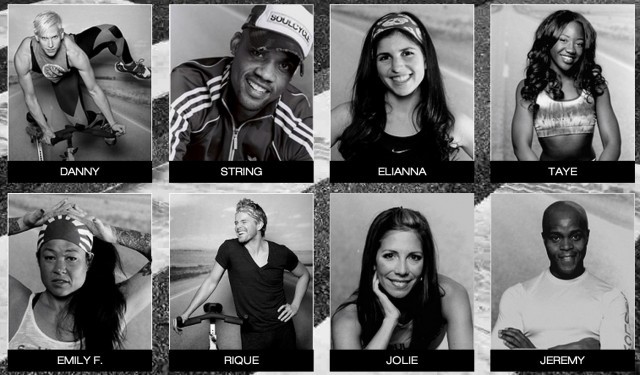
Twenty-thirteen was the year I got super into SoulCycle. It’s gross but I don’t care because I need it and I love it (ha ha so gross). Actually, wait, that’s completely misleading because I only got into it two months ago. Whatever, it’s the best. In October, I bought a block of 20 classes which cost exactly one million dollars. Now I go like three times a week. Over a year this works out to all the money I can imagine in my brain in one go.
Here’s the main reason I go: three out of the five times I go, I cry. No joke. I’m obviously workshopping a mess of garbage in these 45-minute, $34 (I KNOW!!!!) spurts and when I went full-time freelance in February I stopped buying clothes, shoes, cigarettes, weed, cocktails (what a racket) and pounds of bulk gummy candy. It’s not that I became healthy necessarily but I am working hard to be less pissed off all the time since I’m by myself a lot. I’m also trying out tea as a concept and so far it’s going pretty good.
(Pluswhich, I just have other potentially more expensive issues to untangle like how I’m over winter as a concept and want to move the fuck out of New York to a location that may not even exist in the physical realm.)
Another huge part of how I FOUND MY SOUL (hahaha still gross) is that I don’t have regular human office person hours. This means I don’t go to SoulCycle early in the morning or after work. I also don’t try that shit on weekends. I go at either 10:30 a.m. or 4:30 p.m. when it’s not a sold-out clusterfuck of sweaty rexis and vein-faced dudes which is the case if you go at popular times. That said, one time I went on a Saturday because I wasn’t paying attention and it ended up being awesome. It was packed and Temazcal-ish, everyone was into it and I wound up huffing a crazy amount of off-gassed human energy that made me vampire-powerful.
The grody aspect isn’t just that it’s prohibitively priced. I’m not telling you about SoulCycle because I think most people will like it even if it didn’t cost insane clown money. It’s spectacularly cheesy (side note: I also got my aura read this year [review: everybody should do it, hurry up.]). They also have a whole cornball clothing line with massive logos and slogans like TAP IT BACK (an SC move) which is so derp if you think about crew-neck sweat tanks saying shit like grapevine or beto shuffle. Honestly, can sand the floor live even? Some clothes have a skull on them. It looks like badassery that roller derby girls would be hyped on. And everybody knows roller derby girls are depressing as fuck.
Anyway, the walls of each studio are lined with inspirational pack mentality mottos and I ignore all of it for the same reasons that Lululemon’s whole scene feels sketchy. Because you know how you like people who like Lululemon but who cares because everybody’s so old? That.
Thing is, I love this workout so much and having gone through running and resistance training and muscle confusion and private pilates classes and personal training it’s just so nice to walk into a sweatbox and hang your brain on a hook by the door and switch everything off and zone out for a spell. The second I walk out of there — steam pouring off my head — I forget what just happened. It’s really all I’ve ever asked for in an event or activity.
Nothing beats SoulCycle for dumbing all the way out or re-calibrating a mood in less than an hour which is reassuring since I typically wake up in a panic that’s candy-coated with a low-grade rage. I’ve yet to see Jake Gyllenhaal (that’s a thing) but I have seen Kelly Ripa and Vanessa Hudgens. They both sat up front and were teeny and fast like grasshoppers. I always sit in the back (and smoke cigarettes [fuck, i wish.]). I’ve also seen Charlize Theron. She sat in the back, on the bike closest to the door and brought her mother. This confirms all the good things that I believed about Charlize Theron.
There’s reserved seating and when you sign up online you can see a little aerial view of where you’ll be. I like to sit in front of the instructor and away from the fans. Oh, and you have to be at least five minutes early or they’ll give your bike away. Sitting in the back’s the best because it’s where all the new people go. You can be as spastic and uncoordinated as you need to be without feeling a way. But it also doesn’t matter because it’s dark in there most of the time. I like to close my eyes. I’m pretty sure I’m hideous. Like Phoebe from “Friends” when she’s running in the park. Or Elaine Benes when she’s dancing.
The shoes are a pain in the ass because you have to pay more to rent them and they can be intimidating. They’re an additional $3 but you can buy your own pair for about $80 on Amazon with the clips going for an extra $20 or so. I like renting them for now. They also sell you water for $2 but I bring my own because they can fuck themselves straight to hell if they think they’re draining any more goddamned money from me.
Besides, all SoulCycle studios have a filtered water fountain. They also have free combination lockers and showers. The dressing rooms are teeny tiny but they have lotion, face-wash, blowdryers, hair ties, big towels (none of that NYSC bullshit), razors, tampons, deodorant. There’s also Purell and Orbitz gum when you check in. The one on the Upper East Side has free shoe rentals and water because they’re the only ones that don’t have showers.
The deal with the shoes is that they clip into the pedals, fancy road bike style. The rationale is that you work your leg when pushing down on the pedal as well as pulling it up on the rotation since they’re attached to the bottom of your foot. They’re tricky to click in but if you actually just look at the sole you can figure how they’d fit into the mechanism. Press the ball of your foot onto it as if you were putting on a high heeled pump until it clicks. To unclip, straighten your leg and twist the ball of your foot inward to as if you were putting out a cigarette (fuck, I wish).
There’s two helpers per class if you need adjusting or guidance. There’s also extra towels and gel cushions for your seat in case your backside lacks padding like mine and you can taste metal every time you hit saddle. There’s a dial between your legs for resistance.
One of the big draws of SoulCycle is that the music’s so great. There’s themed classes with all Britney or all 80s but I don’t go to those because it reminds me of when people who work in HR wear Halloween costumes. To me the best instructors are the ones who just know how to beat match and sequence songs for pacing. A couple fast songs, a slow, emotional song, some rap shit and then another emo song.
I fuck with Stevie, Josh and String in New York and I love Pixie and Edward in L.A. Also, I tend to like instructors who have maybe been through some shit. I decide this by making generalizations about tattoos. Most of the instructors are pretty good but I avoid all the ones who like mashups because they’re disgusting monsters who need to pull it together.
You will suck really hard the first five times you go and then you get better. Between time one and three you get a lot better while remaining in the suck category. There’s some choreography but it’s not complicated. Mostly, it’s hard to follow along while you want to barf out of your eye ducts.
The main things to remember is hand placement on the handlebars and each class includes a series of push ups on the bars but they’re the wussiest of all wuss-ass push-ups since it’s a tiny movement. Mostly it’s about engaging your core and timing your legs to pump at a pace where you’re not losing control and twatting your face straight onto the handlebars. There’s also a ten-minute sequence where you grab weights that are holstered on either side of your saddle. Mostly though it’s kinda a break for your legs and by the time “arms” rolls around you know you only have one or two songs before you’re done.
The only move you have to learn that’s kinda tricky is “tapping it back.” “It” being your ass. You just scooch your butt until it’s hovering an inch or so above your seat and stay there for a beat. Just hang onto the handlebars and dig in your heel while sending your foot back so you kinda hitch backwards. YouTube it, it’s no big whoop.
When you get better you feel a sense of accomplishment and the prospect of returning to running or UXF will make you too sad to deal. SoulCycle feels gross, is gross and I’m grateful to have found it. If you’ve ever suspected you’d be into it, get over yourself and go. Some of my IRL friends follow them on Twitter so I know they’re sucked in too. I’m so happy to never discuss it with them. Just as I hope if you do try this out, you’ll ignore me if you ever see me in there. Thank you and namaste. LOL.
Runner-ups for the year in review: Having short hair (into it!), wearing Uniqlo longjohns as outside people clothes (because it doesn’t matter! [pro tip: NOTHING DOES. Ha ha. Sorreee. Happy New Year!]).
Mary HK Choi doesn’t believe in shame.
The Top Ten Least Annoying Metal Albums Of 2013
by Michael Robbins
In a taxi after the High on Fire show a few weeks ago, I accidentally listened to “Sound Opinions,” the radio skit show where Greg Kot and Jim DeRogatis say platitudes about rock and roll to each other. It’s a pretty amusing parody of music criticism. In the skit I heard, they pretended that there were still fans of popular music who needed to be persuaded of the importance of the Velvet Underground, so DeRogatis offered a Lou Reed primer (which, in a sly touch, he mispronounced to rhyme with “timer”). The whole thing reminded me why, as much as I love rock and roll, sometimes I hate rock and roll.
It is in this hateful spirit, then, that I offer the following list of the top ten metal albums that annoyed me the least in 2013. Feel free to contribute your own year-end lists in the comments, because I never read the comments.
10. Lycus, “Tempest” (20 buck spin)
Twenty-minute long songs annoy me on principle (except in jazz, where they sometimes annoy me, just not on principle), but these Oakland sludge merchants dredge up a lot of pretty stuff from the muck. In fact, what with the soaring guitar melodies and the occasional breaks into black-metal gallop, this record puts the fun in funeral doom! Ha ha, OK, I’m sorry, fuck off.
9. Noisem, “Agony Defined (a389)
Noise annoys, hell awaits, and the kids are all riled up. What if the early Beastie Boys had been really into early Slayer? I’m just asking. Meanwhile, these Baltimore teens are carving pentagrams into your lawn, dad.
8. Melt-Banana, “Fetch” (a-zap)
If this album doesn’t annoy you sometimes, it’s not doing its job. There’s an awful lot of beeping going on here. Noisy Japanese pancakes at their abrasive loveliest. Play it loud and freak out the cat.
7. Oranssi Pazuzu, “Valonielu” (20 buck spin)
Initially, I was annoyed that this Finnish space ritual is layered with electronics that would have sounded retro on the first Chemical Brothers joint. Now I see that’s part of its genius. Imagine a collaboration between Nine Inch Nails and Hawkwind. This doesn’t sound anything like that, but it’s the best I could do. (One song kind of sounds like Geffen-era Sonic Youth, though, which is OK with me.)
6. Gorguts, “Colored Sands” (season of mist)
This Quebecois death-metal institution’s comeback is a concept record — about a lion who leads some English children into battle against an ice queen, I think — so of course it’s annoying. Also it has a mid-album “classical” piece that is at least as daring as any soundtrack Danny Elfman has scored. But you can ignore the concept and skip the soundtrack. The rest of this meaty, beaty, big bounciness is crammed to the corners with riffy nuance.
5. Subrosa, “More Constant Than The Gods” (profound lore)
This Utah band is said to play doom metal, but I hear something much more expansive than that label suggests. You got Fairport Convention in my Sabbath! It can be annoying that almost every song goes on for over ten minutes (sometimes less is lots, guys), but there’s, like, sublimity in these haunted hooks, or some shit. I swear the end of “Ghosts of a Dead Empire” reminds me of Low.
4. Purson, “The Circle and the Blue Door” (metal blade)
You know what annoys me about this record, is how so many critics have to point out that it’s “not metal.” What are you, the genre cops? Go listen to Pantera. Witchy English perfection here, folks, especially on “Spiderwood Farm” and endlessly catchy closer “Tragic Catastrophe,” about a man who plays “guitar so convincingly tonight.” Plus singer/guitarist Rosalie Cunningham’s alto makes me want to have babies all over the floor. Bonus points for titling a song “Leaning on a Bear.”
3. Kvelertak, “Meir” (roadrunner)
Norwegian rawk, whoda thunk. The only thing that annoys me about this hunky slab of hooks is that the first five songs and the last one are absolute killers, while the five in between are merely good. Also I bought one of their shirts when I saw them open for High on Fire (actually I missed them because I was talking about Hilton Als in a hot dog joint across the street, but High on Fire were great) and it has a really spooky owl on it.
2. Carcass, “Surgical Steel” (nuclear blast)
I’m annoyed that it took me so long to recognize how good these Limey death lifers’ comeback record is. It’s so good, you guys! But finally the album clicked, especially “Noncompliance to ASTM F899–12 Standard” (try saying that five times fast), with its twin guitar-snakes entwining the trellises of my black, black soul as Jeff Walker growls about “the way of all flesh,” and “The Granulating Dark Satanic Mills” (that’s Samuel Butler followed by William Blake, if you’re keeping score at home; told you the Brits have better schools). Dance like Maiden, sting like a blast beat.
1. Inquisition, “Obscure Verses for the Multiverse”
There is nothing annoying about this astrobiological masterpiece.
Michael Robbins is interested in hearing about your band.
